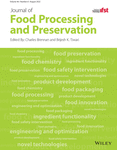Bioink hydrogel from fish scale gelatin blended with alginate for 3D-bioprinting application
Abstract
Nowadays, bioink from natural hydrogel polymer has been used in 3D bioprinting because it is suitable for the in vitro biological growth of human cells. In this work, the blending bioink hydrogel was prepared from fish scale gelatin and sodium alginate from marine bioproducts, fabricated for cell growth. The scaffold was printed with bioink by the 3D-bioprinting method, and samples have tested the printability and physical properties. We found that the best sample, which was prepared from fish scale gelatin at 6 and alginate at 11% (w/v), exhibited 97% of printing accuracy, 538% swelling ratio, and 133 kPa of compressive strength. HaCaT cells, the keratinocyte cell line from adult human skin, were printed together with fabricated bioink and investigated cell viability in a 3D scaffold. The bioink containing cells shows viability with an increasing cultivation time. Therefore, fish-scale-derived bioink hydrogel has biological compatibility with nontoxicity, suitable for scaffold in the 3D-bioprinting application.
Practical applications
The production process and the cost of producing gelatin bioink for bioprinting are now quite expensive. We proposed the bio-functional inks from low-cost materials to reduce costs by using fish scale gelatin from marine food production waste and alginate from seaweed. The gelatin/alginate hydrogel blend produced from fish scales also has properties similar to the porcine gelatin blend used in the current biological inks in tissue engineering applications. Therefore, the key potential usage can be initially applied in the fabrication of tissue skin graft encapsulated with keratinocyte human cells or growth factor for chronic wound healing as a wound dressing substitute.
CONFLICT OF INTEREST
The authors have declared no conflicts of interest for this article.
Open Research
DATA AVAILABILITY STATEMENT
The data presented in this study are available on request from the corresponding author.




